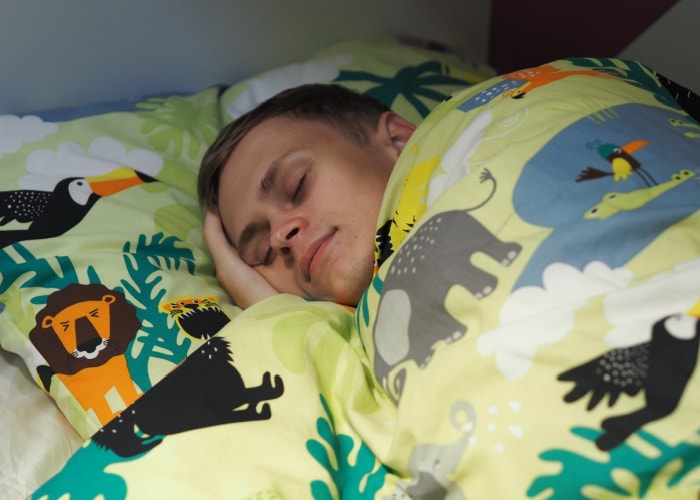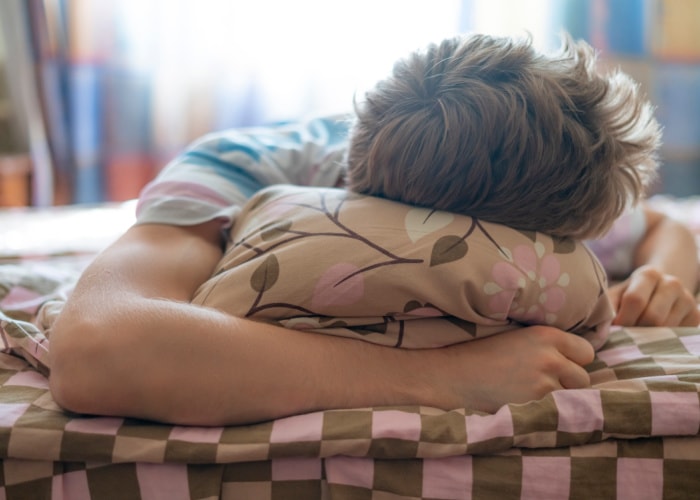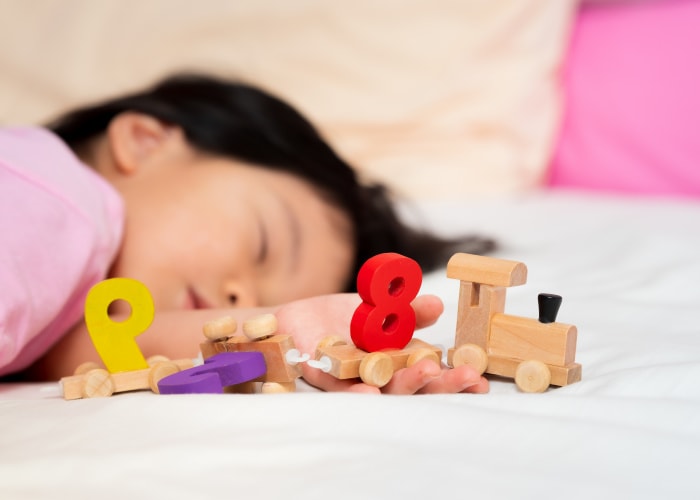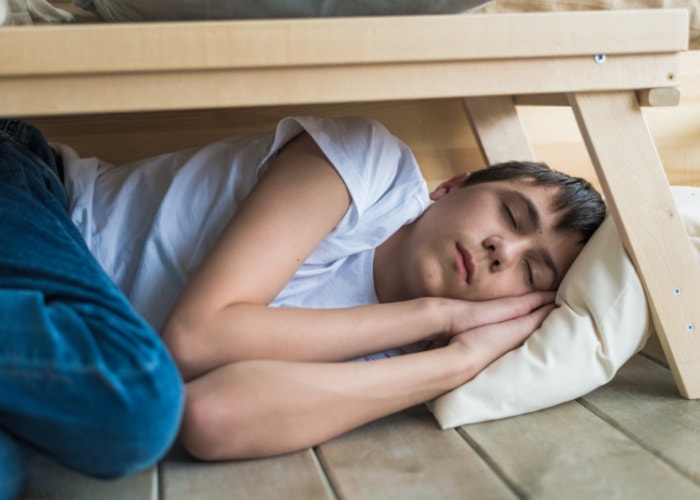Are you tired of feeling sluggish and wondering if toxins might be affecting your health?…

Autistic Child Won’t Sleep Alone: Helpful Strategies for Better Sleep
Having an autistic child won’t sleep alone can be incredibly challenging for parents. The endless nights of disrupted sleep affect not just your child but the entire family. Sleep is essential for everyone’s wellbeing, and finding ways to help your child’s sleep improve can make a significant difference to daily life.
Key Takeaways
- Sleep Challenges for Autistic Children: Understand why many children with autism experience sleep difficulties and how sensory differences can impact their ability to fall asleep and stay asleep.
- Creating the Ideal Sleep Environment: Learn how to set up your child’s room with tools like weighted blankets, blackout curtains, and white noise machines to address sensory issues that disrupt sleep.
- Effective Bedtime Routines: Discover how consistent bedtime routines and gradual approaches can help your autistic child become comfortable sleeping in their own bed and own room.

Why Autistic Children Struggle with Sleep
Many autistic children have difficulty sleeping for reasons directly related to their autism spectrum disorder. Getting to know these challenges is the first step to helping your child get the rest they need.
According to the National Autistic Society, up to 80% of autistic children experience sleep problems compared to just 25% of typically developing children. This isn’t simply being stubborn about bedtime – there are genuine reasons why your autistic child won’t sleep alone.
Autistic children often have heightened sensitivity to sensory differences in their environment. Things we might not notice, like the hum of an appliance or a small amount of light coming through curtains, can feel overwhelming. They might also struggle with transitions from day to night and changes to routine, while experiencing higher levels of anxiety at bedtime. Many also have irregular natural sleep patterns that don’t align with typical schedules.
For many parents, this situation means years of co-sleeping arrangements or taking turns staying with their child until they fall asleep. While this might work temporarily, it’s not sustainable and can lead to sleep deprivation for everyone involved.
Setting Up the Ideal Sleep Environment
The right environment can make a massive difference to your child’s ability to sleep alone. Small changes to your child’s room can address many sensory issues that make it hard for them to relax and fall asleep.
Research from Great Ormond Street Hospital shows that sensory-friendly sleep spaces can significantly improve sleep quality for autistic children. Creating the right sleeping space is often more effective than medication or other interventions.
Making the Room Sleep-Friendly
A dark room with minimal distractions creates the ideal conditions for sleep. Install blackout curtains to block out all light, as even small amounts of light can be distracting for sensitive children. Use a white noise machine to mask disturbing sounds from inside or outside the home. It’s also helpful to remove stimulating items like electronic devices or bright toys and keep the room at a comfortable temperature.
The NHS Sleep Support Service recommends keeping bedrooms slightly cool (16-18°C) for optimal sleep conditions.
Addressing Sensory Needs
Many autistic children have specific sensory issues that affect their sleep. A weighted blanket can provide comforting pressure that helps many children feel secure. Be mindful of certain fabrics that might irritate your child – pay attention to what bedding materials they prefer.
| Sensory Tool | How It Helps |
|---|---|
| Weighted blanket | Provides deep pressure touch inputs that can calm the nervous system |
| White noise | Masks unpredictable sounds that might startle or distract |
| Soft lighting | Reduces visual stimulation before sleep |
| Comfortable pajamas | Avoids irritation from certain fabrics |
Let me know if you want it formatted for a specific platform, like WordPress or Google Docs.

Building an Effective Bedtime Routine
A consistent bedtime routine is crucial for any child, but especially for those with autism. The same routine every night helps your child understand when it’s time to sleep.
According to Autism UK, predictable routines help reduce anxiety by making the world more understandable and less overwhelming for autistic children. This is particularly important at bedtime when your child needs to feel safe enough to let go of consciousness.
Your child’s sleep routine should start at the same time each night and include calming activities that your child enjoys. Work on gradually moving towards independence in small steps and avoid stimulating activities or electronic devices before bed.
Remember that changes won’t happen overnight. It may take weeks or even months of consistent practice before your autistic child is comfortable enough to sleep alone.
Gradual Approaches to Independent Sleep
Many parents find that a step-by-step approach works best when teaching an autistic child to sleep alone in their own bed. The Sleep Council UK recommends gradual withdrawal techniques rather than sudden changes, which can trigger anxiety and resistance.
The Chair Method
This gentle approach involves gradually moving further away from your child’s bed each night. Start by sitting on your child’s bed until they fall asleep, then over time move to sitting on a chair right next to the bed. Each night, gradually move the chair further away until you eventually sit outside the bedroom door. The final step is to say goodnight and leave.
This method can take several weeks, but it allows your child to adjust gradually rather than facing the change all at once. Research published in the Journal of Child Psychology and Psychiatry shows that gradual approaches are particularly effective for children with autism who often struggle with sudden transitions.
Using Visual Supports
Visual schedules can help your child understand the bedtime process. Many autistic children process visual information more easily than verbal instructions.
Create a visual chart showing each step of the bedtime routine with a final image of your child sleeping alone in bed. Review the schedule together before starting the routine and refer to it throughout the process. The Autism Education Trust offers resources for creating effective visual supports for various situations including bedtime.

Tracking Sleep Patterns
Keeping sleep diaries can help you identify patterns in your child’s sleep habits and provide valuable insights. The NHS Sleep Service recommends tracking sleep for at least two weeks to identify meaningful patterns.
In your sleep diary, note when your child seems most tired and what activities help them fall asleep. Pay attention to what might be causing them to wake during the night and whether certain foods or activities seem to affect their sleep. This information can be valuable when working with healthcare professionals to address persistent sleep problems.
A study from King’s College London found that detailed sleep diaries helped identify specific triggers for sleep difficulties in autistic children that weren’t obvious to parents before tracking.
When to Seek Professional Help
If your autistic child continues to have trouble falling asleep despite your best efforts, it may be time to consult with professionals who specialize in sleep difficulties in neurodivergent children.
According to NICE Guidelines (National Institute for Health and Care Excellence), persistent sleep problems in autistic children often require specialist assessment and support. Their guidelines recommend seeking professional help when sleep issues significantly impact daily functioning.
Consider reaching out if your child experiences night terrors or severe anxiety around sleep, or if sleep deprivation is affecting your child’s daytime functioning. Professional help may also be needed if your family is struggling with severe fatigue due to disrupted nights or if you suspect there might be medical reasons for the sleep issues, such as sleep apnea.
Some families find that working with specialists in ABA therapy or occupational therapy through the Royal College of Occupational Therapists can provide strategies tailored to their child’s specific needs. Your GP can also refer you to NHS sleep specialists or developmental paediatricians who work with autistic children.
Supporting the Entire Family
When an autistic child won’t sleep alone, it affects everyone in the household, including other children. Research from Carers UK shows that parents of children with additional needs often experience significantly higher stress levels due to sleep disruption.
Taking care of your own needs is essential for sustainable parenting. Take turns with your partner if possible so each of you gets some rest. Many local authorities offer respite care services that can provide much-needed breaks. Be patient with yourself and your child, and remember that progress may be slow but is still valuable.
The Contact charity offers support specifically for families of disabled children, including advice on managing sleep issues and accessing respite care.

Overall
Teaching an autistic child to sleep alone requires patience, consistency, and understanding. By creating the right environment, establishing predictable routines, and slowly building independence, many parents can help their children develop healthier sleep patterns.
Research published in the BMJ suggests that consistent sleep interventions show positive results in over 80% of cases, though the timeframe varies significantly between children. Remember that small steps forward are still progress, and what works for one child may not work for another.
While it can be challenging when your autistic child won’t sleep alone, with time and the right approach, many families do find solutions that work for them. The goal is not just to have your child sleep alone but to help them feel tired at the right time, fall asleep comfortably, and wake refreshed improving quality of life for your entire family.
Frequently Asked Questions
Why do autistic children have trouble sleeping alone?
Children with autism often experience sensory differences that make it difficult to filter out environmental stimuli. This heightened awareness, combined with potential anxiety and difficulty with transitions, can make sleeping alone challenging. According to Autism Research UK, many autistic children also have differences in melatonin production, the hormone that regulates sleep-wake cycles.
How long will it take for my autistic child to learn to sleep alone?
Every child is different, but teaching an autistic child to sleep alone typically takes consistency over weeks or months. It won’t happen overnight, but small, gradual steps can lead to significant improvements. The Sleep Foundation reports that most families see meaningful progress after 2-3 months of consistent practice.
Are weighted blankets safe for children?
Weighted blankets can be safe and beneficial for children over a certain age and weight, typically around 3 years old. The Royal Society for the Prevention of Accidents advises that the blanket should weigh no more than 10% of your child’s body weight. Always consult with healthcare providers before introducing a weighted blanket.
Can melatonin help my autistic child sleep?
Some parents find that melatonin supplements help their autistic child with difficulty falling asleep. The British Association for Psychopharmacology notes that melatonin has shown positive results in research studies with autistic children, but you should always consult with a healthcare provider before giving any supplements to your child.
What if my child has a meltdown at bedtime?
If your child regularly has meltdowns at bedtime, try to identify triggers in their routine or environment. The Challenging Behaviour Foundation suggests keeping a detailed record of what happens before, during and after meltdowns to spot patterns. You might need to adjust your approach, make the transition to bed more gradual, or provide additional sensory supports.
How can I help my other children when so much attention goes to sleep issues?
When one child requires extra support at bedtime, it can be challenging to balance attention between siblings. Sibs UK, a charity supporting siblings of disabled children, recommends creating special time with your other children during the day and considering staggering bedtimes so each child gets individual attention.
Should I use a reward system for sleeping alone?
A reward system can be effective for some children, but it needs to be immediate and concrete. For example, a sticker chart with a small reward after collecting a certain number of stickers for sleeping in their own bed might work well. The Association for Child and Adolescent Mental Health notes that rewards work best when they’re simple, immediate, and highly motivating for your specific child.
How dark should my child’s room be?
Many autistic children sleep best in a completely dark room. The Sleep Charity recommends blackout curtains for creating optimal sleep conditions, but always ensure there’s enough light for safety if your child needs to get up during the night. A very small nightlight that doesn’t emit blue light can be a good compromise.



This Post Has 0 Comments